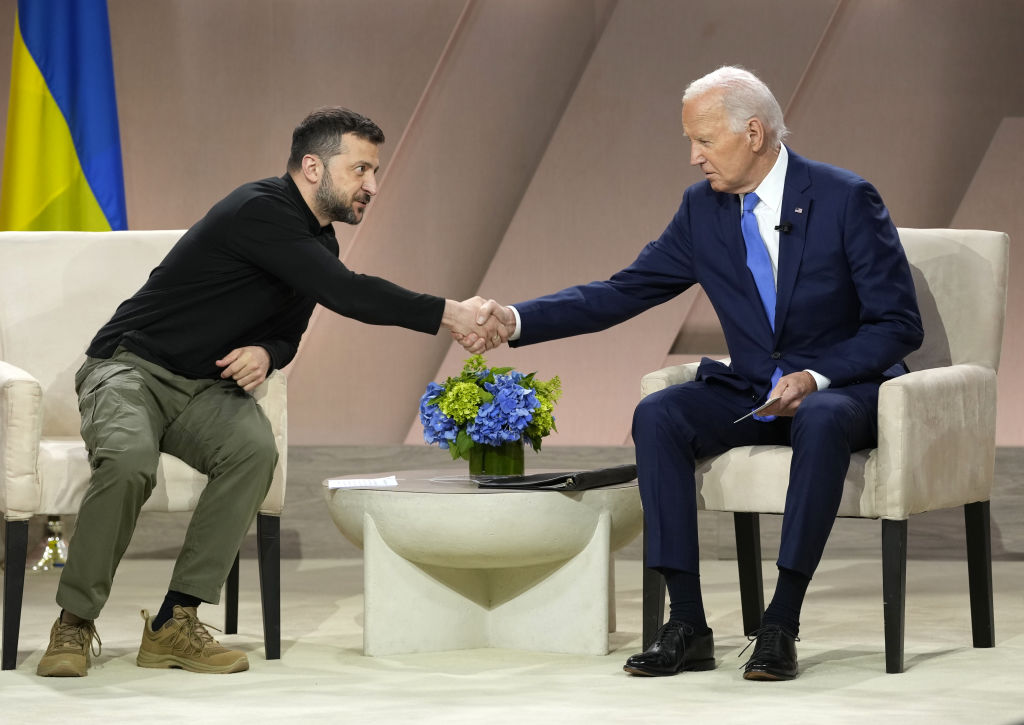World
Why Nato fears for its future

“Inevitably, it became a referendum on Biden’s age.”
The President’s lapses of memory and coherence weren’t such a surprise. Earlier this year, Biden twice referred to dead European leaders — former German Chancellor Helmut Kohl and former French President François Mitterrand — when referring to recent discussions with foreign counterparts. At the summit, Biden did not mistake contemporary leaders for those long dead, but he did confuse allies with enemies, calling Ukrainian President Zelensky “Putin” and Kamala Harris “Vice President Trump”.
With Biden faltering so badly, the spectre of a new Nato-sceptic Trump administration drew closer, prompting some of the more hawkish member states to tailor their talking points to address the Republicans. At one panel composed of the three top defence officials from Estonia, Latvia and Lithuania, participants spoke in a language they knew the Trump camp would understand: golf. “Nato is a club,” Estonian Defense Minister Hanno Pevkur said. “When you have club rules, then you respect the rules and you expect that everyone will also respect the rules. When you pay your fee in the golf club, you can play. It doesn’t matter how big is your wallet.” They hammered away at the idea of all those members who were now spending 2% of GDP on defence, hoping to convince Republicans that Europe was now pulling its weight. And yet, as international relations theorist Patrick Porter told me, this “magical 2% figure” was arrived at with full US commitment in mind. Europeans are still avoiding the difficult question: if America scales back its commitments in Europe under a Trump presidency — many in his camp advocate for a “pivot to Taiwan” and a shift of focus to the Indo-Pacific — who will fill in the gap?
In fact, much of the summit did seem to be a carefully calibrated pitch to America — or at least those Nato sceptics at the RNC. Kosovo’s Prime Minister Albin Kurti, whose country is a Nato aspirant, wrote a front-page op-ed in the New York Times with the title “Don’t Doubt NATO, it Saved My People”, outlining the role the alliance played in ending the Kosovo conflict in 1999. Meanwhile, Latvia’s President Edgars Rinkevics addressed the criticism that the US does much more than Europe to support Ukraine, claiming that in truth, it was the other way around. “It’s also very important to explain to the American public,” Rinkevics said in a speech on Tuesday. European Atlanticists fear an American retreat from the continent under Trump, who has complained that Europe has given too little aid to Ukraine, while the United States has given too much.
The contentious subject of Ukraine’s future membership in Nato was the other big theme of the summit. Germany and the United States are unwilling to extend full Nato membership while Ukraine is still at war with Russia. Instead, they say, Ukraine should be granted a “bridge to Nato”, a nebulous promise that fell far from aspirations of full membership that Ukraine has been waiting for since 2008. However, some felt the language of the communique was made stronger by the insertion of the word “irreversible”: apparently the bridge to Nato can only be crossed in one direction. But the Ukraine section of the Washington Summit Declaration, published last week, was ambiguous about its future. “We reaffirm that we will be in a position to extend an invitation to Ukraine to join the Alliance when Allies agree and conditions are met.”
Meanwhile, Ukraine and its supporters in Eastern Europe are adamant that the country be granted membership, or at least a timetable for it. Only full membership, they claim, can deter Russia. Some suggest that Article 5 security guarantees — the provision that states that an attack on one member state is an attack on all — be introduced incrementally, first on territory already under Ukrainian command, and eventually under those parts of the country Zelensky’s forces win back.
But critics counter that admitting Ukraine risks triggering all-out war with Russia. They contend that membership would make it far more difficult to negotiate a ceasefire or engage in peace talks, since Russia has long insisted that Ukraine in Nato is a “red line”. And they point out that, contra the exalted Atlanticist rhetoric surrounding the current war, Nato has no intention of fighting for Ukraine. And if Nato is not committed to entering the war now, as Ukraine is fighting for its life, then it certainly isn’t going to make any promises about some undefined point in the future. They suggest a dialing down of the rhetoric and scaling of expectations. In fact, dozens of foreign policy experts signed a controversial letter ahead of the summit urging caution. “If Ukraine were to join NATO, Russia would have reason to doubt the credibility of NATO’s security guarantee — and would gain an opportunity to test and potentially rupture the alliance. The result could be a direct NATO-Russia war or the unraveling of NATO itself.”







:max_bytes(150000):strip_icc()/roundup-writereditor-loved-deals-tout-f5de51f85de145b2b1eb99cdb7b6cb84.jpg)


